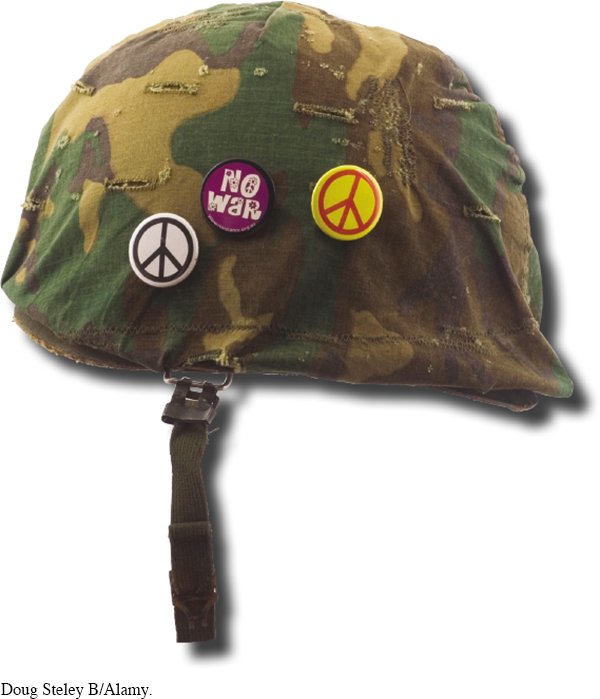The American Promise: Printed Page 831
The American Promise, Value Edition: Printed Page 754
The American Promise: A Concise History: Printed Page 860
Introduction to Chapter 29
The American Promise: Printed Page 831
The American Promise, Value Edition: Printed Page 754
The American Promise: A Concise History: Printed Page 860
Page 83129
Vietnam and the End of the Cold War Consensus
1961–

CONTENT LEARNING OBJECTIVES
After reading and studying this chapter, you should be able to:
Describe President Kennedy’s more aggressive implementation of the containment policy. Identify his approach to the third world, and explain U.S. involvement in Cuba and Vietnam.
Explain why Johnson escalated involvement in Vietnam, and evaluate the effectiveness of this strategy.
Explain how the war polarized the nation and contributed to a year of upheaval in 1968.
Describe Nixon’s approach to communism, including his pursuit of détente with the Soviet Union and China and anticommunism efforts in the third world. Explain how Nixon ended the war in Vietnam and the legacies of the war.
LIEUTENANT FREDERICK DOWNS JR. GREW UP ON AN INDIANA farm and enlisted in the army after three years of college. Leaving a ten-
That confidence was tempered by what they found in Vietnam. Unlike most of America’s previous wars, there was no fixed battlefront; helicopters ferried fighting units all over South Vietnam, as U.S. and South Vietnamese troops attempted to defeat the South Vietnamese insurgents and their North Vietnamese allies. In a civil war characterized by guerrilla tactics, Downs and his men struggled to distinguish civilians from combatants and destroyed villages just because they might be used by the enemy. He had faith that his country could win the war, but he found the South Vietnamese army to be lazy and ineffective. “Maybe the people in Nam are worth saving, but their army isn’t worth shit,” he wrote in his memoir. Downs won several medals for bravery, but his one-
The American Promise: Printed Page 831
The American Promise, Value Edition: Printed Page 754
The American Promise: A Concise History: Printed Page 860
Page 832Downs served in Vietnam at the height of a U.S. engagement that began with the Cold War commitments made by Presidents Harry S. Truman and Dwight D. Eisenhower. John F. Kennedy wholeheartedly took on those commitments, promising more flexible and vigorous efforts to thwart communism, declaring that the United States would “pay any price, bear any burden, meet any hardship, support any friend, oppose any foe to assure the survival and the success of liberty.”
Kennedy sent increasing amounts of American arms and personnel to sustain the South Vietnamese government, and Lyndon B. Johnson dramatically escalated that commitment in 1965, turning a civil war among the Vietnamese into America’s war. At peak strength in 1968, 543,000 U.S. military personnel served in Vietnam; all told, some 2.6 million saw duty there. Yet this massive intervention failed to defeat North Vietnam and created intense discord at home, “poisoning the soul of America,” in Downs’s words. Some Americans supported the government’s goal in Vietnam and decried only the failure to pursue it effectively. Others believed that preserving a non-
This internal conflict was just one of the war’s great costs. Like Downs, more than 150,000 soldiers suffered severe wounds, and more than 58,000 lost their lives. The war derailed domestic reform, depleted the federal budget, disrupted the economy, kindled domestic discord, and led to the violation of protesters’ rights, leaving a lasting mark on the nation.
Even while fighting communism in Vietnam and in other third world countries, American leaders moved to ease Cold War tensions. After a tense standoff with the Soviet Union during the Cuban missile crisis, the United States began to cooperate with its Cold War enemy to limit the spread of nuclear weapons. In addition, Richard M. Nixon made a historic visit to China in 1972, abandoning the policy of isolating China and paving the way for normal diplomatic relations by the end of the 1970s.
CHRONOLOGY
| 1961 |
|
| 1962 |
|
| 1963 |
|
| 1964 |
|
| 1965 |
|
| 1967 |
|
| 1968 |
|
| 1969 |
|
| 1970 |
|
| 1971 |
|
| 1972 |
|
| 1973 |
|
| 1975 |
|